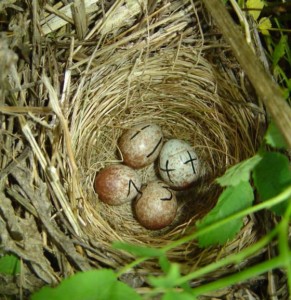
News/Reports
Indirect predator effects on clutch size and the cost of Egg production
 Abstract
Abstract
Predator-induced changes in physiology and behaviour may negatively affect a prey’s birth rate. Evidence of such indirect predator effects on prey demography remains scarce in birds and mammals despite invertebrate and aquatic studies that suggest ignoring such effects risks profoundly underestimating the total impact of predators. We report the first experimental demonstration of indirect predator effects on the annual ‘birth’ rate resulting from negative effects on the size of subsequent clutches laid by birds. We manipulated the probability of nest predation and measured the size of subsequent clutches and multiple indices of the mother’s physiological condition, while controlling for food availability, date and stage of breeding. Females subject to frequent experimental nest predation laid smaller subsequent clutches and were in poorer physiological condition, particularly regarding non-resource-based indices (e.g. oxidative stress and glucocorticoid mobilization) consistent with both a response to the threat of predation and an increased cost of egg production.
Keywords
Clutch size, cost of reproduction, egg production, nest predation, non-consumptive effects, oxidative stress, predator–prey ecology.
Ecology Letters (2010) 13: 980–988
Marc Travers,1,2 Michael Clinchy,3* Liana Zanette,2 Rudy Boonstra4 and Tony D. Williams1 1Department of Biological Sciences, Simon Fraser University, Burnaby, BC V5A 1S6, Canada 2Department of Biology, University of Western Ontario, London, ON N6A 5B7, Canada 3Department of Biology, University of Victoria, Victoria, BC V8W 3N5, Canada 4Centre for the Neurobiology of Stress, University of Toronto at Scarborough, Toronto, ON M1C 1A4, Canada *Correspondence: E-mail: mclinchy@uvic.ca
See the PDF file: Travers_et_al_2010
